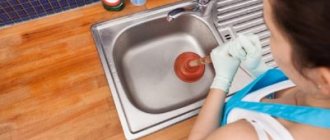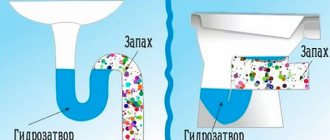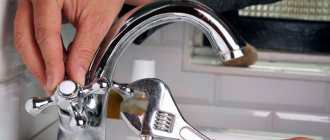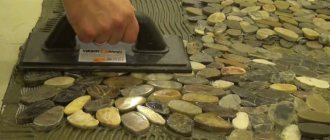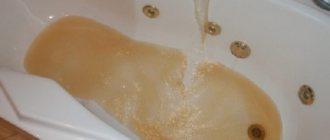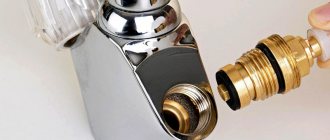The condition of the bathroom faucet depends not only on the quality of care, but also on the tap water. White spots on plumbing fixtures are not always traces of soap stains. Often these are so-called hardness salts, which are found in excess in the water supply. Together with drops of water, they settle on various surfaces and, after drying, form a persistent limescale deposit. And if soap residues are easily washed off with water, then removing plaque will require some effort and the use of special products.
Household chemicals in the fight against water stone
The easiest way to get rid of water scale and soap deposits is to resort to modern household chemicals. But when using such potent and aggressive products, the following facts must be taken into account:
- Clean plumbing fixtures only with chemicals that are approved for use on the specific material.
- Metal taps and mixers coated with decorative enamel (made from unusual materials) can easily be damaged by using aggressive cleaning agents.
- Never use cleaning powders or bleaches intended for cleaning the bathroom, sink or washbasin.
- Most taps are treated with chromium, which reacts very strongly to acids. The metal begins to turn black, scorched spots appear on it, which will be impossible to remove.
Carefully study the composition of cleaning products. They should not contain sulfuric, phosphoric and hydrochloric acids, as well as chlorine.
Restoration of damaged coating
If, through negligence, an inappropriate product was used and the faucet became dark, you can contact a workshop and try to restore the chrome coating. But this method has two significant drawbacks:
- Not all workshops undertake the restoration of plastic parts, which are often included in cheap faucets.
- The high cost of the procedure - often it is half the cost of a new mixer. Therefore, restoration of the coating is beneficial only for expensive models.
Note: The popular method suggests polishing the damaged areas of the faucet using GOI paste: this way you can partially mask the dark spots. The working surface is pre-treated with machine oil. The paste is applied to a napkin or rag (in no case to the mixer itself). The product is carefully polished until the desired result is obtained. After polishing, the paste is removed with solvent or water.
Cleaning the aerator
Cleaning soap deposits on the outside of the faucet is only half the battle. Modern faucets are equipped with aerators - this is a small metal nozzle with a mesh on the spout of the tap. This small part serves to enrich the water with oxygen and thereby performs a number of useful functions:
- Reduces the noise level of flowing water due to the fact that many small bubbles soften the flow of water.
- Reduces splashing.
- Additional filtration from small debris that occasionally occurs in tap water.
- The aerator helps by maintaining good pressure with minimal water consumption. Savings depending on the model can range from 50 to 80%.
It often happens that the aerator becomes clogged with lime flakes and ceases to efficiently cope with its functions. In this case, it needs to be removed and cleaned.
How to understand that it’s time to clean the aerator:
- The tap is fully open, but the water barely flows
- The water flows unevenly, the flow either increases or decreases
- There is water in the system, but it does not pass through the mesh holes
To work, we will need pliers, a rag and a container with detergent.
Carefully wrap the nozzle in a rag, pinch with pliers and turn clockwise. And here the owners of cheap Chinese plumbing fixtures are in for an unpleasant surprise: aerators for such faucets are most often made of extruded aluminum or plastic coated with a shiny coating; both materials are fragile and often break when you try to unscrew them. If the aerator bursts during dismantling, do not despair, buy a new one. High-quality plumbing aerators made of steel or brass last much longer.
If the nozzle is jammed, then use WD-40 or vinegar, wet a cloth, wrap it around the nozzle, wrap it with a plastic bag on top and leave until the mobility of the thread is restored, this is about 2-3 hours.
After you have unscrewed the aerator, rinse it from large contaminants under the running tap, and then place it in a glass with 9% vinegar. The exposure time depends on the degree of contamination and varies from 1 to 12 hours. After the time has expired, rinse the aerator with clean water and, if necessary, clean the holes with a darning needle.
Assemble the clean nozzle and screw it into place; there is no need to tighten it, so you can easily unscrew it with your fingers at any time and wash it. It is advisable to remove and rinse the nozzle once a week, then the aerator will work properly.
What to do if the faucet is jammed
Sometimes faucets become jammed and stop functioning properly. In this case, two means are used.
Vinegar solution
If the faucet stops working due to salt deposits, you will have to remove it and soak it in a vinegar solution. In this case, the mixture should not be very concentrated. Therefore, vinegar is mixed with water in a ratio of one to three.
WD-40
This is one of the most effective solvents, used not only in everyday life, but also in industry. In order for the faucet to work, you will have to spray all the places where a lot of salt deposits have accumulated.
Preventive actions
Even with increased water hardness, contamination of the faucet will not be a problem if you properly care for your plumbing equipment. For example, you can use the following methods:
- install filters for water softening;
- install coarse and fine mechanical filters;
- Use suitable cleaning products;
- remove lime deposits while they are fresh;
- cover external surfaces with a special shampoo, which forms a film that protects against contamination.
Then maintaining the good condition of the equipment will not be a hassle.
Using the techniques described, any skillful owner will be able to clean the faucet. To do this, you need a screwdriver, a wrench and a special tool for removing rust and lime deposits. The main thing is to remember to turn off the hot and cold water shut-off valves before starting work. All these efforts will not be in vain. A smooth, powerful stream from the tap will help you do all your household chores quickly and easily.
Every person at least once in his life has encountered the problem of how to remove limescale from a tap, but few people have thought about the true reasons for its appearance. The fact is that the water that is supplied to our houses and apartments through pipeline systems always contains various mineral impurities. Their number may vary depending on the area of residence, but they still exist and have a direct impact not only on water hardness, but also on the formation of unpleasant deposits on the internal and external surfaces of pipeline equipment. In this article we will tell you how to clean limescale from your faucet at home and how to avoid further contamination.
Methods for cleaning a nickel-plated or chrome-plated faucet
Such surfaces require careful care. They need to be thoroughly cleaned and disinfected. You can clean the faucet using the following products:
Dishwashing liquid. Take 1 glass of warm water and mix 1 tablespoon in it. detergent
Then take a sponge soaked in the prepared solution and carefully clean all parts of the structure
Please note: the spout, base, levers and valves of the faucet should be thoroughly cleaned.
Baking soda. To clean rust from a chrome bathroom faucet, you will need baking soda. Take a soft sponge and lightly dampen it with water, you can also use a cloth. Using them, spread the baking soda over the surface and leave it for 30 minutes. After this, the soda can be washed off with cool water.
White vinegar. Pour white vinegar (6%) into the spray bottle and spread it over the surface of the product; mineral deposits will begin to dissolve. Leave the vinegar drops on for 10 minutes. Then the mixer should be wiped with a dry cloth.
How to clean the inside of a shower head using citric acid?
“Limonka” is extremely effective if the shower head is clogged , which can, if not unscrewed, then be placed in a container without disconnecting from the hose. Citric acid is poured into an enamel container and poured with boiling water, after which a watering can is placed in it for 10-20 minutes.
Once cleaning is complete, you should also rinse the shower by turning on the warm water at maximum power.
Folk remedies
Despite the abundance of different types of household chemicals, folk remedies that are easily prepared at home are still popular. These are solutions and pastes based on lemon, soda, vinegar or other products.
Lemon
This type of citrus fruit has long been used as a natural cleanser due to its high acid content. The fruit must be cut into two halves, the cut side should be treated with chrome surfaces and wait 10 minutes until the acid destroys the salt deposits. Then wipe the mixer dry with a soft, dry cloth. Citric acid can be an effective alternative. In a specially prepared container you need
- pour out a small amount of crystalline substance;
- add some water;
- mix everything thoroughly until completely dissolved;
- soak a soft sponge in the solution;
- clean the areas affected by plaque.
Soda
To use this product, soda slurry is prepared. The cooking process is simple and does not take much time:
- Place a few spoons of powder in a cup;
- dilute it with a small amount of water;
- mix until smooth;
- leave for up to 5 minutes until large abrasive particles dissolve.
When the paste is ready, it should be applied to the chrome parts of the washbasin and left for an hour. After this, the product must be carefully removed with a soft cloth without applying force. If there are any stains left, they can be wiped off with light movements using a soft sponge.
Vinegar
Vinegar solutions are another popular cleaner option. The composition may include table vinegar with a 9% concentration or its apple equivalent. An essential component is water, which is mixed with vinegar in equal parts. After cooking
- the sponge is moistened with the solution;
- treat plumbing;
- wait a few minutes;
- Using a soft cloth, wipe everything dry.
The solution immediately reacts, allows you to quickly get rid of lime deposits, and the lack of abrasive properties protects the sensitive surface from scratches.
Coca Cola
Since the appearance of this overseas drink in the former USSR, housewives quickly discovered its amazing ability to cleanse dirt. In this case, no preparatory procedures are required, it is enough
- soak a piece of cloth in soda;
- put it on the sink faucet;
- hold the compress for about 20 minutes;
- wash the treated surface from any remaining dirt and drink;
- wipe with a dry cloth.
The acids that make up Cola destroy water stone and restore the shine of the surface without damage.
Laundry soap
- grind the soap into shavings;
- dissolve with a small amount of hot water;
- add a little baking soda;
- mix the ingredients until a paste with a homogeneous consistency is obtained.
The mixture is applied in a continuous layer over the entire surface of the tap and left for about an hour. To completely clean it of scale residues, you will need to rinse everything off with running water.
General recommendations
The most important thing: before you start disinfecting and cleaning, you need to determine the type of faucet covering. This is required for the correct choice of products and more delicate cleaning of the surface of the mixer based on its characteristics:
- When cleaning, do not forget about the mixer aerator, since this is where scale and rust particles settle;
- You should not use abrasive products to clean sanitary ware, because aggressive cleaning can severely damage the surface of the faucet;
- when cleaning the surface with a sponge, you need to wash the faucet with the softer side to avoid abrasions and visible scratches;
- To make taps and bathtubs sparkle and delight you with mirror cleanliness, you can try applying a little delicate glass cleaner to the faucet before final wiping with a dry cloth.
Natural remedies
Unfortunately, allergies are becoming one of the most common diseases in the world. Often allergic reactions are caused by household chemicals. In such cases, you can try to clean the faucet and taps in the bathroom using simple natural methods.
- Baking soda.
Dip a slightly damp washcloth in baking soda and wipe the surface with it. Rinse with water. - Soap solution.
Dissolve laundry soap in hot water. The resulting thick solution removes limescale well. If you add a spoonful of soda to the soap solution, the effectiveness will increase. - Lemon acid.
You can take crystalline citric acid, but it is better to clean the mixer with half a lemon. Dipping the lemon cut into fine salt will make the process even easier. Citric acid must be washed off well. - A weak solution of vinegar, table or apple cider vinegar.
Prepare a solution by diluting 9% table vinegar by half. Dampen a soft cloth or brush in it and clean your bathroom and kitchen faucets. Rinse with water.
In hard-to-reach places, taps can be cleaned with a soft toothbrush. Great for cleaning chrome surfaces in the bathroom, a special microfiber cloth.
Baby oil
An unusual faucet cleaner is baby oil.
Procedure:
- moisten a soft cloth with baby oil;
- wipe contaminated areas;
- wash off any remaining oil with water;
- Polish the faucet with a soft cloth, such as flannel or suede.
Baby oil copes well with soap stains, greasy stains and fresh limescale.
Handy means
If you do not have the opportunity to use special formulations, due to the high cost or allergies to household chemicals, then we resort to the help of folk remedies.
First, you need to make it a rule that after using the mixer, wipe it with a dry cloth every time - and there will be nothing to clean. But, you must admit, it’s difficult, there’s still the same rush, lack of time, or simply laziness, mother. Therefore, we will consider care options that will replace expensive products.
Lemon or citric acid, which many use to clean teapots from lime deposits. An effective and proven remedy. But use not a concentrated solution if it is a whole lemon, but a slightly diluted juice with water. Otherwise, it is better to use the liquid that remains after boiling and cleaning the kettle, but this time it is warm, and not boiling water.
Removable chrome parts, such as an aerator, can be soaked in this solution for 10 minutes.
Advice. Avoid contact with marble products.
Baking soda is good at removing grease and lime deposits. But it should also be diluted with water to a paste-like consistency, otherwise you will scratch the product.
Mustard powder diluted with water, or mustard. Before using, try this product on hidden areas. There is little information about its reaction with chromium, but it is not so popular either.
Baby body oil is good at removing soap and grease stains, as well as stubborn lime deposits.
It’s up to you to decide what you use to clean the faucet, but remember, saving on care products can result in a completely uneconomical replacement of the entire faucet.
Cleaning agents for removing limescale
For adherents of household chemicals, the market offers a huge selection of cleaning products for cleaning faucets or mixers from limescale.
Tip: when buying a special powder, carefully study the label. Otherwise, there is a risk of saying goodbye not only to plaque, but also to your own plumbing.
Anti-corrosion inhibitors
Cheap detergents do not contain valuable anti-corrosion inhibitors. Inhibitors prevent aggressive additives from damaging the metal. With them, the entire attack is aimed exclusively at lime deposits. Therefore, look for anti-corrosion inhibitors in the composition of the product.
Sulfuric, hydrochloric or nitric acids
Acids are rather heavy artillery for cleaning faucets. They decompose not only plaque and rust, but also enamel and metal coatings. Products with such acids can only be used in advanced cases and only when wearing gloves.
For daily treatment, it is better to choose softer products - based on surfactants.
. When released into water, they are almost completely biodegradable and do not damage the skin of the hands.
What to choose: liquid or cleaning agent?
The powder has an abrasive structure and is best used for cleaning bathtubs and sinks. It is better to entrust the care of metal surfaces to liquid products. Apply the product to the surface, leave for 5 - 10 minutes, rinse with water. And enjoy the shine!
Tap water contains minerals, which determine its hardness and the faucets' hardness during operation.
Impurities settle on pipes and taps, and limescale forms. Faucet care includes not only daily wiping of moisture, but also regular cleaning of mineral deposits inside and outside.
Basic mistakes
There are several mistakes that many people make when cleaning their taps.
Using metal sponge
Some people use very hard sponges made of metal to remove plaque.
However, their use is contraindicated, since after their use scratches and other mechanical damage may remain on the surface. Therefore, it is better to rub the contaminated surface with other products.
Wrong choice of cleaning product
Before cleaning, you need to choose the right cleaning products, as some of them cannot be used.
Abrasive particles
Sometimes cleaning compositions contain abrasive components that can damage the surface of the faucets. Therefore, when choosing a detergent, you need to carefully look at what substances are present in its composition. If there are a lot of abrasive particles in it, you will have to stop using such solutions.
Acids
Some believe that products containing acids are more effective in combating scale. However, such compositions are not suitable for taps and damage their coating. Therefore, to clean contaminants, it is contraindicated to use liquids that contain the following acids:
- phosphorus;
- sulfuric;
- salt.
If you use them, the surface will become covered with dark dots that cannot be washed off.
A mixture of various products
There are times when people mix several detergents at once and use the resulting composition to remove limescale stains. However, the results from using such mixtures may be unexpected and therefore it is better not to use them.
What not to clean
The top layer of faucets is very easy to spoil. And this will no longer be the product that attracts with its shine and specularity. Chromium, as a chemical element, reacts with various types of acids and their compounds. Thus, the surface is destroyed, darkens, and becomes dull. What acids are not used? Oxalic acid, acetic acid, orthophosphoric acid, chloric acid and others.
Carefully read the instructions for cleaning products; they should be specifically for chrome-plated products. For example, I had to deal with such a well-advertised product as Silit. After using it, the shower head became covered with dark spots. It is designed to remove lime deposits, but not from chrome surfaces!
Also, do not use abrasive, powdery substances for care. It is because of their consistency that coatings are damaged. It is clear that micro scratches cannot be avoided during operation, but there is no need to create them on purpose.
In cheap, low-quality products, not only the top layer, but also the inner layer is erased at the site of chips and damage. As a result, the same lime, chlorine, and soap solution get into them, which leads to further destruction. Eventually some of the chrome may peel off.
You cannot use sponges with a hard surface, for the same reason - they leave scratches. In hard-to-reach places, use a toothbrush, but again with soft bristles. Otherwise, a sponge with microfiber or a simple cloth is best.
General rules for cleaning faucets
The chrome surface is easily damaged due to improper mechanical and chemical influences. The following recommendations will help you avoid the formation of defects on the mixer and make work comfortable:
- To remove plaque from chrome plating, it is unacceptable to use any rough materials, such as metal brushes and scrapers, hard sponges and graters. Otherwise, scratches and oxidation of the coating in places of damage are inevitable. Subsequently, further oxidation and contact with water will lead to rust.
- Do not use abrasive substances, products based on chlorine (Domestos, Belizna) and aggressive acids (phosphoric, sulfuric, hydrochloric, as well as concentrated formic and oxalic). They are really great at removing limescale, but they come into contact with metal surfaces, forming black dots and dark spots on them. As a rule, it is impossible to remove such defects. Typically, the instructions on the packaging of such cleaning products indicate the area of use and contain a special warning “Do not use on chrome surfaces.” Therefore, you should not neglect reading this information.
- After removing dirt, the mixer and taps are polished with a cloth - this way the surfaces will remain shiny longer.
- Hard-to-reach areas can be cleaned well with old toothbrushes and kitchen bottle brushes.
- Aluminum foil soaked in water effectively removes rust from a chrome surface. Aluminum reacts with the damaged surface and removes stains.
- The exposure time to cleaning agents, especially professional ones, should not be exceeded.
- When working with vinegar and household chemicals, be sure to thoroughly ventilate the room. Inhalation of acid fumes and other volatile compounds may cause allergic reactions and irritation of the upper respiratory tract.
Use of household chemicals
You can also clean your faucet from limescale using specially designed cleaning products that are sold in every household chemical store. However, there are several very important points to consider when choosing and using chemicals:
In this article, we have shared with you the most effective methods on how to remove limescale from a faucet, and we sincerely hope that following these recommendations will help keep your plumbing clean.
Housewives are well aware of the problem of calcification of chrome-plated plumbing elements. To restore their previous appearance, you have to look for effective means that allow you to remove limescale from the faucet quickly and without damaging its surface.
The cause of limescale is associated with the high content of calcium and magnesium salts in the water. When you open a tap, especially hot water, it produces steam, which condenses and forms a deposit. In the absence of timely care, it crystallizes over time, turning into a persistent white scale that is difficult to remove with regular wiping.
Causes of plaque
Plaque on plumbing appears due to increased water hardness, which is determined by the concentration of mineral salts.
As a rule, calcium and magnesium salts predominate in the water supply. Mixing with soap suds, they leave white marks and streams on surfaces. When the content of iron salts in water is high, a yellow precipitate is formed. But the untidy appearance of the faucet is only an external manifestation of the problem. Limescale deposits are also deposited on the internal surfaces of faucets - after all, there is always a certain amount of water there. In advanced cases, water stone forms on the moving parts of the structure, which disrupts the operation of the taps and can cause them to fail. Moreover, the rate of deposit formation directly depends on the frequency of use of hot water. At temperatures above 70 °C, salts settle much faster, forming scale. This problem is usually typical for boilers and washing machines, but can also affect faucets. Therefore, it is necessary to promptly clean them not only outside, but also inside.
How to clean shower head holes
If the holes of the hydromassage nozzle are clogged, we will use heated vinegar; by the way, vinegar is a universal home remedy that housewives use for various purposes. With its help you can clean rooms and even remove various types of household pollution.
Unscrew the shower head, disassemble it into parts and soak them in heated vinegar for 1-2 hours, after which, armed with a darning needle, thoroughly clean all the holes and reassemble everything as it was. Instead of vinegar you can use " CilitBang"
"and an old toothbrush. When the limescale is finished, reassemble the watering can and attach it back to the hose.
Wax shampoo
Some housewives have found a way to not only clean the taps, but also protect chrome parts from limescale for a week. To do this, they use waxy car wash shampoo. This product is designed to protect the car body from adverse weather conditions. The wax included in the shampoo forms a thin water-repellent film on the surface, protecting the metal from corrosion. You can buy wax shampoo at any auto store.
Apply a drop of shampoo to the sponge and thoroughly wash all chrome surfaces in the kitchen and bathroom. Polish with a soft cloth or microfiber cloth to a mirror shine. That's all, you can forget about limescale for at least a week.
Restoration of darkened plumbing fixtures
I may disappoint readers, but it is impossible to restore chrome plating at home. However, you can significantly improve the appearance of a faucet damaged by acid or chlorine and partially restore its lost shine. To do this, use polishing paste for chrome car parts, for example: “AREXONS Mirage Cromature Brillanti” (Italy), Goya paste (made in the USSR) or another similar product. A wide selection of similar products is available in any car store; ask the seller and he will advise you on a suitable polish.
You need to apply the paste to the damaged surface and polish it for a long time with a piece of felt; if you have a sanding machine with a felt attachment in the house, then the work will go much faster. Since the coating is already damaged, this procedure will have to be repeated from time to time.
There are sparkling taps in every kitchen and every bathroom. These are absolutely necessary technical devices in the household. In addition, stylish faucets in classic or modern designs have long been interior decoration.
Suddenly the faucet begins to hiss and snort, and the stream loses pressure. The reason for this may be calcium deposits contained in tap water. To eliminate the breakdown, the mechanism must be thoroughly cleaned and defective parts replaced.
Traditional faucets have two separate valves for cold and hot water. Recently, they are gradually being replaced by single-lever designs. Which model is preferable in terms of design and technical structure, everyone chooses for themselves.
Two-valve
In such a mixer, the force of water flow is controlled by the so-called axle-box taps. There are two of them: separately for cold and for hot water. Typically one of three types is used:
- worm;
- lamellar;
- ball
When we turn the valve, the shut-off mechanisms open the way for the appropriate flow. After passing through the faucet, the water is mixed in the spout.
Single lever
A special cartridge is built into the body of such a mixer, which contains two ceramic plates ground to each other. When the lever handle is turned, the plates move relative to each other. At the same time, the holes through which water passes expand or close.
There is also a model where the plates are replaced by a hollow ball with holes. Hot and cold flows mix into this chamber and enter the faucet spout through the outlet. The control lever moves the ball, thus regulating the pressure and temperature of the water.
Ball
For installation in the bathroom, faucets can be equipped with a ball switch. It allows you to redirect the flow of water between the shower and the gander, i.e. the spout of the faucet. Structurally, this device is close to a ceramic crane axle box. Adjustment is made by rotating a small lever.
This mechanism is extremely reliable and is less prone to breakdowns, unlike another popular type - the push-button shower switch.
Is it possible to avoid plaque formation?
It is impossible to avoid the appearance of plaque inside the faucet. Although in different regions of our country water has different hardness, it still contains a certain amount of magnesium and potassium salts, which form plaque.
But it is quite possible to restore external beauty and shine if you make it a rule to wipe the faucet after use. A napkin or the soft side of a sponge is suitable for this purpose.
Tap water always contains minerals. In some regions there are more of them in the water, in others there is much less, but they are definitely there. Not only the hardness of the water, but also the condition of your faucet depends on their quantity. It is because of mineral salts that whitish spots of dull limescale appear on the shiny surface of a chrome faucet. No self-respecting housewife will leave this disgrace unattended. How to clean a bathroom faucet without damaging its surface?
Instructions for disassembling and cleaning the inside of the mixer
If the faucet often clogs, it needs to be disassembled and cleaned inside. Before you begin dismantling the unit, you should determine its type. The following options are available for sale:
- With 2 valves and valve axle boxes.
- With cartridge and 1 lever.
- Ball models.
Double valve design
To disassemble a mixer with 2 valves, you must:
- Shut off the water supply. A locking mechanism is installed in the bathroom or toilet.
- Remove the assembly. To do this, you need to unscrew the nuts securing the housing to the eccentrics. At this stage it is important to be careful not to damage the nuts.
- Get rid of the plugs on the valves. Below them is a screw that will need to be loosened to remove the valve.
- Unscrew the valve axle and remove it from its seat. Actions with the second valve are carried out according to a similar scheme.
- Remove the gooseneck from the mixer. To do this, you need to unscrew the union nut.
Disassembling a two-valve type mixer.
After disassembling, the parts need to be cleaned by first removing all the gaskets. This is a mandatory action, especially when caring for old crane axle boxes. It is important to assess the condition of the gasket and, if necessary, replace it with a new one.
With one lever
To disassemble a mixer with 1 lever you need:
- Shut off the water supply.
- Unscrew the fixing screw.
- Remove the handle from the cartridge rod.
- Unscrew the skirt holding the cartridge and unscrew the nut.
- Take out the cartridge.
The gaskets are located on the bottom of the cartridge. If they are out of order, it is better to change them.
Ball
Ball mixers are modern plumbing products and are in demand due to their ease of use. Such units rarely leak and maintain economical water consumption.
Since the faucet comes with one adjustment knob secured with a screw under the cover, the dismantling process does not take much time.
First you need to remove the faucet handle by loosening the screw that holds it in place. Next, press the notch of the threaded ring and carefully turn the ring counterclockwise. Then you need to remove the chrome dome and take out a plastic structure that resembles a shield. Traces of dirt can be removed with any folk remedy or household chemicals.
Chemicals
A more effective way to remove stone is to use household cleaners. It is advisable to use products specifically designed for stainless steel surfaces with chrome plating. Popular drugs include
- Russian Sanox, for metal sanitary ware and products with a ceramic base for similar purposes;
- Ravak Cleaner Chrome from a Czech manufacturer for equipment coated with chrome;
- Cif from Hungary, well known to domestic housewives, designed for cleaning metal;
- another domestic product, Cillit Bang, effectively removes salt deposits from metal parts;
- German Top House is designed for the care of kitchen sinks and other stainless steel equipment.
A necessary and general condition for the use of these compounds is the protection of the skin, in some cases the eyes and respiratory organs. Other details of use should be found on the label or in the accompanying instructions, if provided. For final shine, you can use polishes, which, among other things, can create a film that prevents calcification. Such substances include Indesit and Dumax.
This information will be useful for novice housewives who do not always know how to clean a faucet from limescale deposits of varying complexity at home.
How to avoid plaque
In full accordance with the saying “prevention is better than cure,” it is much easier to prevent calcium deposits from occurring than to struggle with its removal. There are three main preventive measures that can solve this problem:
- wipe the tap after each use, preferably dry;
- carry out regular cleaning at least once a week;
- prevent plumbing leaks and correct faults in a timely manner.
Liquid or solid products: which is better to use?
For a knowledgeable person, such a dilemma does not exist. The choice should definitely be in favor of liquid preparations that are gentle on the surface. Most powders are abrasive, which can damage surfaces.
Should you use a water filter?
According to user reviews, filters are a really useful thing. They remove excess salts and soften the water, reducing the likelihood of deposits forming. There are reagent and non-reagent varieties. When choosing the first option for filter devices, you will have to regularly spend money on updating the reagent. The second one is more economical, despite the additional energy consumption, and is not inferior to its reagent analogues in terms of efficiency. Another advantage of the electromagnetic option is the ability to act equally on cold and hot water.
A little bit of science
First, let's study a little what a chrome surface is. In our minds we are always talking about a shiny and mirror structure. Visually everything is correct, but from the point of view of galvanoplasty everything is much more complicated. Chromium itself is not used in its pure form; in the process of applying it to the surface of products, its compounds (solutions) are used. Moreover, chrome plating is carried out on the so-called sublayer, which can be a thin film of copper or nickel. Thus, the resistance of such a surface to destruction is significantly increased. The components of almost all high-quality faucets are presented as follows: the base is brass, the sublayer is nickel and the top is chrome.
On cheap products made from silumin, galvanic application of chromium is difficult to implement, so special varnishes are widely used. This product has nothing in common with real chrome plating, which can be distinguished by its cool blue tint.
In general, when choosing a faucet for a bathroom or kitchen, focus on the weight of the device and the shade of its surface.
Methods for getting rid of limescale
Modern household chemicals are the simplest and most common method of cleaning plaque on bathroom faucets. But the use of such funds has several nuances. To avoid damaging taps and mixers, use only cleaning fluids that are suitable for them.
Under no circumstances should rust removers or bleaching agents be used. Chrome, which is usually used to coat plumbing fixtures, is very active. When interacting with acid, it begins to break down. This results in dark spots that are difficult to remove. Before using household chemicals, you should always study its composition. Liquids for chrome-plated products must be free of chlorine, hydrochloric, phosphoric, and sulfuric acids.
Do not use powdery substances for cleaning. Abrasive particles can damage the integrity of the coating. After using each product, it must be thoroughly rinsed with water, especially before applying the next one. Otherwise, a chemical reaction between various products may damage the product. To avoid damaging your hands, you must use protective gloves. If you need to remove plaque inside the product, it should be disassembled. If this cannot be done, then simply disconnect the tap and soak it for 30 minutes in a vinegar solution, then rinse.
Folk remedies
You can also clean plaque at home using folk remedies:
- 1. One of the most common ways to clean a product from plaque is to use a metal scraper. This product is designed to remove old food or solids from dishes. The shape of the mesh allows you to remove dirt even in hard-to-reach places. But it is recommended to use special gloves for washing so as not to damage the skin of your hands. The only drawback of the scraper is that pressing hard can leave marks and scratches on the faucet.
- 2. Using table salt allows you to remove limescale in a few minutes. To do this, just pour salt onto a damp cloth and rub the surface of the plaque. If the plaque is no more than a year old, then removing it will not be difficult. In this case, there will be no marks or scratches on the tap.
- 3. Using lemon is also quite effective, but you must remember the harmful effects of acids. To clean, rub the plaque area with lemon and leave for 20 minutes. To enhance the effect, you can first rub with a cloth with salt and then with lemon. After time has passed, rinse the resulting solution with cold water and wipe with a dry cloth. By the same principle, you can use citric acid by dissolving it in water.
- 4. Using baking soda not only removes limescale, but also makes the chrome surface of the faucet shine. The principle of use is similar to the use of salt. You need to pour baking soda onto a damp cloth, rub the surface of the plaque, then rinse everything off and wipe dry. If the plaque is not removed the first time, you can repeat the procedure, but leave the soda on the mixer for two hours. To help the baking soda absorb better, you can apply it with a soft brush.
- 5. The easiest way to remove dirt is with vinegar. There are several options for doing this: apply the solution to the faucet and cover with cling film, or soak a rag in vinegar and leave on the tap for 30 minutes. Be sure to rinse off the vinegar thoroughly after cleaning. Shower heads simply need to be disconnected and placed in a plastic bag along with a weak acid solution.
Rust removal
Getting rid of scale is not the only problem. Even though clean water flows from the tap, its surface may become rusty. This is especially true for iron products that are susceptible to corrosion. How to remove rust stains?
It sounds strange, but the best solution when rust appears is semi-coarse flour. First, degrease the product with warm water and dish gel. Pour flour into a bowl, dip a sponge in water, in flour, wipe the rusty areas. Although at first glance this may seem incredible, in fact, this method is more effective than the similar (but harmful to chrome and nickel) procedure for removing rust with a cleaning powder.
If you still prefer powder, do not use it in its pure (abrasive) form. Place the powder in a bowl and add some water to create a soft paste. Carefully clean the rusty areas and rinse.
Cleaning the aerator and shower head
It is not enough to clean only the outer surface of the faucet. Limescale also accumulates inside.
Over time, it can cause plumbing to fail.
Modern faucets are equipped with aerators - meshes on the spout of the faucet. When this part is clogged, it must be removed and cleaned.
Signs that the aerator is clogged:
- when the tap is fully open, the water pressure becomes very weak;
- the water flows unevenly, the flow periodically intensifies;
- the most advanced case is that water does not flow, although it is in the system and the tap is open.
Aerator cleaning steps:
- First you need to unscrew the faucet nozzle. To do this, you need to wrap it in a rag, clamp it with pliers and turn it clockwise. Cheap Chinese plumbing fixtures usually have plastic or aluminum aerators installed. Therefore, they break when the nozzle is unscrewed. In this case, you should buy a new aerator from a plumbing store. A high-quality part can be made of brass or steel and will last much longer than before.
- If the nozzle does not unscrew, you can apply a vinegar compress to it. After a few hours, mobility will be restored.
- The unscrewed aerator should be cleaned of large debris with running water.
- Then place the product in a container with 9% vinegar and leave for 1-12 hours, depending on the contamination.
- After the allotted time has passed, rinse the aerator under running water and carefully clean the holes with a needle.
- The cleaned nozzle should be assembled and screwed into place.
It is recommended to rinse the aerator once a week, then cleaning will take place much faster.
The holes of the hydromassage nozzle often become clogged. You can clean your shower head with heated vinegar. To do this you need:
pour table vinegar into a container and heat it; soak parts of the disassembled shower head in warm vinegar; leave for 1-2 hours; after this time, rinse the parts with running water and carefully clean the holes using a needle; assemble the watering can and screw it back.
Dealing with old limescale is not the easiest task. It can cause the faucet to break down. To prevent this, you need to regularly clean the plumbing from plaque. Then it will serve the owner for many years.
Special compounds for plumbing
Place the faucet in a solution of liquid Antiscale to clean it inside
Liquid Antiscale and Cillit will clean the faucet from the outside and inside. To do this, you will have to first remove it or at least unscrew it from the sink and leave it to soak in the prepared solution. After soaking, all that remains is to rinse the faucet with clean water and put it back in its original place, then drain the water so that the inner surface is thoroughly washed from contaminants.
To remove limescale, you should not purchase products containing nitrogen, salt, sulfur or phosphorus compounds. The use of such compounds can lead to a new problem - the formation of dark spots and rust that is difficult to remove, so they are best used in very rare cases. Manufacturers of such products are required to notify buyers of the content of potent substances with an inscription on the label.
How to clean a faucet from rust, scale and other contaminants
In order to clean the faucet from rust, scale and other contaminants, you can use a variety of chemicals. It is not recommended to use compounds containing aggressive acids and chlorine. You also need to be careful with abrasive powders so as not to damage the chrome surface.
Cleaning products
You can find a variety of formulations on sale that will effectively help in the fight against pollution.
The most famous of them is “Silit”. Please note that regular gels for cleaning bathtubs and toilets, as well as bleaches, are not suitable for cleaning the inside of faucets. The most popular home remedies are:
The most popular home remedies are:
- laundry soap;
- lemon acid;
- baking soda.
You should not mix different products, as you may accidentally end up with a caustic composition that will damage the metal. Before cleaning, put on rubber gloves to protect your hands from harm.
How to clean a faucet
If there is a light coating, you can simply wash the device with an appropriate product. If the deposits have penetrated deeply, you will have to remove and disassemble the entire mixer. Coarse dirt and rust from the internal parts can be cleaned with steel wool.
When cleaning external chrome surfaces, abrasive powders should be avoided.
If you cannot disassemble the faucet, you can soak it in detergent for several hours, in the hope that the lime build-up inside the device will dissolve or become brittle and fall off on its own. But there is no need to leave metal products in the solution for too long.
Removing limescale
Lime deposits are formed due to the presence of large amounts of calcium in the water. Hard water enters the water supply network quite often. White spots and stains can be easily removed from the surface of the faucet using laundry soap or soda. If there are persistent stains, you can cover them for a while with a cloth soaked in vinegar or a solution of citric acid, then rinse the part with clean water. It is better to use special products to treat internal surfaces.
Rust removal
If there is a significant amount of rust, it must first be cleaned off with a wire brush or sandpaper. The remaining traces, as well as slightly affected areas, are treated with the usual means: vinegar, soda, lemon juice.
You can try to wipe off the rust with a rag soaked in machine oil or kerosene. Car owners use a car cleaner for this purpose, or you can buy a special household anti-rust product in the store.
How to clean the aerator filter
The cause of a weak, uneven stream from the tap may be a clogged filter aerator. It often becomes clogged with small debris contained in the water. In addition, fine mesh is also susceptible to salt deposits and rust. The aerator is carefully unscrewed and immersed in the vinegar solution. Then it is rinsed and put in place.
If the filter is so “grown” to the tap that it is impossible to remove it, the cleaning solution is poured into the bag. This bag is hung on the tap, immersing the part of the device to be cleaned into it.
In the video, the author explains which components of the mixer need to be checked in order to improve the water supply.
Process considerations for precious metal taps
If the faucet is made of copper, brass, bronze or other noble metals, it is cleaned with special household chemicals. Brass products are treated with a cloth soaked in a soap composition or solution based on citric acid, vinegar and salt.
Copper is treated with salt and citric acid. Bronze parts are susceptible to staining. To eliminate the problem, it is enough to regularly care for the device with water and chicory powder. The remaining metals are cleaned with tomato paste, which is applied to the problem area for 30 minutes.
